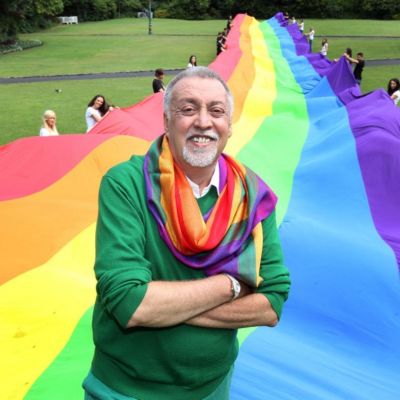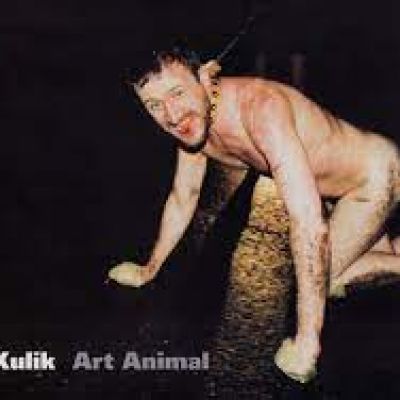Gilbert Baker – Biography
Page Contents
The rainbow flag was designed by LGBTQ rights campaigner and artist Gilbert Baker.
Gilbert Baker- Birth, Age, Ethnicity, Siblings, Education
Gilbert Baker, an American artist, and advocate for LGBTQ rights who referred to himself as the “gay Betsy Ross,” designed the rainbow flag. His work as a talented lexicographer (flag builder) for 30 years set two world records. The LGBTQ movement was defined and consolidated in part by Baker’s artistic output. At the age of 65, he passed away on March 31, 2017.
In the little rural Kansas town of Chanute, Gilbert Baker was born on June 2, 1951. His mother worked as an educator, and his father held positions as a judge and attorney. His parents were well-known members of the community. Baker was pleasant and extroverted as a child, yet he experienced discrimination due to his sexual orientation.
Baker spent a year in college after finishing high school before being drafted into the Army. Just as the gay freedom movement was taking shape, Baker was posted to San Francisco. He was dismissed with honor after completing a brief two-year time and afterward assimilated into San Francisco’s flourishing activist scene.
Baker joined the Sisters of Perpetual Indulgence, a non-profit LGBTQ advocacy group whose members dress as nuns to raise awareness of gender and sexual prejudice, and performed in drag shows during the 1970s. Baker, a rising activist, and well-known drag perform
Using his drag queen costume sewing expertise, Baker, who later served as Milk’s right-hand flagman, created and sewed several banners opposing the Vietnam War and promoting homosexual rights. Milk was positioned beneath Baker’s first rainbow flags when they appeared.
Gilbert Baker- Professional Career
As the gay liberation movement gained popularity, Milk and other individuals worked with Baker to design a symbol for it. As Baker explained in an interview with the New York Museum of Modern Art shortly after they bought his original flag design in 2015, the group concentrated their efforts on designing a flag because “flags are about asserting authority, so it’s extremely suitable.”
In 1978, Baker started working on creating a symbol for the LGBT liberation movement. He aimed for it to be stunning, distinctive, and a clear reflection of the LGBTQ community. Eight vibrant stripes, hot pink for sexuality, red for life, orange for healing, yellow for the sun, green for nature, blue for art, indigo for harmony, and violet for diversity, made up the first pride flag (human spirit).
In the attic of the Gay Community Center in San Francisco, Baker assembled the first two flags that flew in the San Francisco Gay Freedom Day Parade on June 25, 1978, using eight metal garbage cans filled with natural colors and organic cotton with the assistance of volunteers.
The demand for the rainbow flag significantly surged after Milk’s murder in November 1978. However, due to a lack of hot pink fabric (and the associated cost), there were only seven stripes on the flag, which were later reduced to six stripes (red, orange, yellow, green, blue, and violet) to ensure symmetry if the flag had to be split in half during parades and festivals.
The current six-striped rainbow pride flag, which is flown all over the world as a symbol of LGBTQ support, represents the variety of the LGBTQ population.
On May 18, 2019, American actor Miles Teller smiles for the camera during a photocall for the movie “Too Old To Die, Young – North of Hollywood, West of Hell” at the 72nd Cannes Film Festival in Cannes, southern France.
WASHINGTON, DC – MARCH 02: On March 2, 2011, in Washington, DC, ranking member U.S. Rep. Barney Frank (D-MA) interrogates U.S. Federal Reserve Chairman Ben Bernanke during his testimony at a hearing of the House Financial Services Committee in the Rayburn House Office Building on Capitol Hill on receiving “the Monetary Policy Report to the Congress required under the Humphrey-Hawkins Act.”
Republican criticism of the Federal Reserve’s monetary strategy drew a response from Bernanke. (Image courtesy of Getty Images/Jonathan Ernst)
On October 2, 2010, in New York City, actor Ben Whishaw attended the premiere of “The Tempest” as part of the 48th New York Film Festival. (Image courtesy of Getty Images/Astrid Stawiarz) Local captioning Whishaw, Ben
More artwork and rainbow flags
As an artist for Paramount Flag Company, Baker continued to promote the rainbow flag, and he attributes this company to helping to popularize the rainbow flag by mass-producing it. Baker rose to prominence as an artist for regional, statewide, and international events throughout the 1980s, including the 1984 Democratic National Convention. Additionally, he created flags for several foreign leaders, including the President of Venezuela, the King of Spain, the Chinese Premier, and the Spanish monarch.
Even during Bill Clinton’s administration, one of Baker’s 1992 rainbow silkscreens was displayed in the White House’s West Wing office complex.
At events like World Pride in Rome (2000), the New York Gay Community Center (2002), the San Francisco Public Library (2003), and the San Francisco LGBT Community Center, Baker displayed his rainbow flag fabrics, photography, oil paintings, and other artwork for viewers all over the world (2003). The famed MOMA in New York City has acquired his original flag design for their collection.
Rainbow Flags Breaking Records
In 1994, Baker received a contract to create a mile-long, 30-foot-wide rainbow banner that 10,000 participants would carry in a parade in New York City to commemorate the 25th anniversary of the Stonewall uprising. In 2003, Baker once more produced a massive rainbow pride flag to mark the 25th anniversary of the flag itself.
This time, the original eight colors were used to create the mile-and-a-quarter-long flag that covered Key West from the Gulf of Mexico to the Atlantic Ocean. Guinness Globe Records acknowledged them as the two largest flags in the history of the world after each occurrence. More than a hundred towns throughout the world received pieces of the enormous flags that were divided up.
Death and Memorials
In addition to creating the well-recognized LGBTQ pride sign, Baker also wrote essays, articles, and talks, and produced artwork on the rainbow flag. He opted to view the rainbow flag as his gift to the world rather than having his flags ever be copyrighted. He even went back to San Francisco to recreate the flags and banners he had initially created in the 1970s to add realism to Sean Penn’s Academy Award-winning 2008 film Milk.
To celebrate the 39th anniversary of the first rainbow flag, he designed 39 nine-color flags that contained “the eight original hues, plus lavender to reflect the diversity,” according to his obituary in the New York Times, just before he passed away.
At the age of 65, Baker passed away from cardiovascular disease brought on by hypertension and atherosclerosis in his New York City residence on March 31, 2017. His life is honored in the 2003 documentary Rainbow Pride, and The GLBT Historical Society in San Francisco has a display of the original sewing machine he used to make the first flag.




